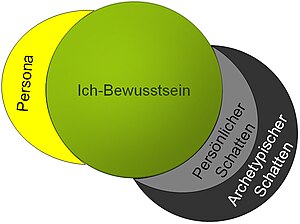persona
In psychology, persona is the outwardly shown attitude of a person, which serves his social adaptation and is sometimes also identical with his self-image. The term corresponds to the Greek πρόσωπον / prosopon = face, which, like the Latin persona, already in antiquity refers to the meanings 'actor's mask' (as in ancient theater ), 'role' (in acting or life), 'official position' and in general ' Person ' / 'Personality' fanned out. The word 'persona' was also understood as the ' sounding through' ( personare = sounding through, letting the actor's voice sound through) through his mask, which typified his role . Recently, "persona" has also been used for bogus identities shown on the Internet.
Analytical psychology


The Swiss psychologist CG Jung transferred the term to depth psychology and wrote: The persona "is, as its name suggests, only a mask of the collective psyche, a mask that pretends individuality that makes others and you believe that you are individual, while it is only an acted role in which the collective psyche speaks. " "It is a compromise between the individual and society about 'what one appears as'." The term describes that part of the ego that ensures a 'normal', socially acceptable behavior of the individual towards his environment - and insofar as the persona likes to pretend to be 'the me', it can also be interpreted as a "wrong me" . The characteristics of the persona are therefore mainly acquired by adapting or adopting socially (or subculturally) desirable ideas. Adaptation, however, often takes place at the expense of individuality . The danger of adapting too much to social conditions puts the individual in danger of conflict with the unconscious individual part of his or her psyche, whose socially unfavorable areas are often kept in the 'shadow' of relative unconsciousness. Thus, the ego-consciousness typically stands between the poles of its 'light' persona and its 'dark' shadow . The persona is a kind of 'clothing' of the ego, which both offers protection to the individuality hidden behind it and offers a starting point for normal (situationally conventional) communication.
Jung described the chances and dangers of the mental process when the conventional persona is dismantled by content erupting from the unconscious. The "unleashing of involuntary fantasy" brings to light a mixture of individual and collective unconscious content. This could either bring about a salutary change in personality or a complete absorption of people in mass movements . On a positive note, the persona has a double protective function: it can protect a sensitive inner life from being attacked and devalued by other people. And it can protect other people from dangers (e.g. sexual or political violence) by suppressing their destructive impulses from potential perpetrators in order to preserve the persona (here e.g. good reputation and social position). Conversely, in the positive case, the task of a socially defined persona can help a person to constructively realize his inner life (e.g. as an artist).
Jolande Jacobi described some 'roles' that people would also assume in terms of persona in society:
- the hero (recognition as a social role model),
- the Redeemer (social recognition as a moral or religious ideal, partly against ruling political influences),
- the avenger (conscious action against collective morality for different motives),
- the martyr (victim of collective morality),
- the outcast (social exclusion),
- the vamp (female behavior to "turn the tables" in a male-power-oriented environment).
Individual evidence
- ↑ CG Jung (1921, 8th edition. 1949): Psychological types. GW 6: § 801 f.
- ↑ Sources: Oxford Dictionary, Langenscheidt's Latin Dictionary, English Wikipedia.
- ↑ Source: http://www.duden.de/rechtschreibung/Persona#Bedeutung2 , accessed on March 17, 2016
- ^ CG Jung (1928, 2nd ed. 1934): The relationships between the ego and the unconscious . GW 7, quote §245.
- ↑ Ibid .: 246
- ↑ CG Jung, GW 6: §370
- ^ CG Jung (1928, 2nd ed. 1934): The relationships between the ego and the unconscious . GW 7: §250-253.
- ^ Jacobi, Jolande : The psychology of CG Jung . An introduction to the complete works. With a foreword by CG Jung. Fischer Taschenbuch, Frankfurt March 1987, ISBN 3-596-26365-4 , page 36 ff.